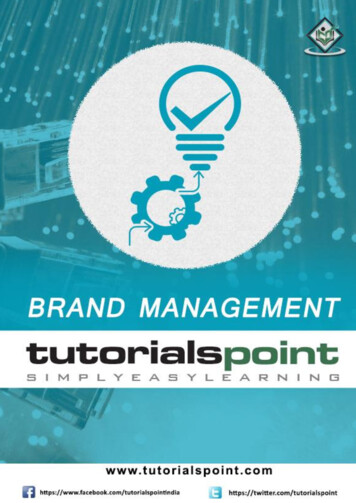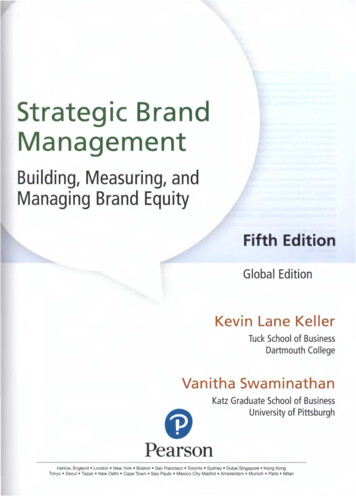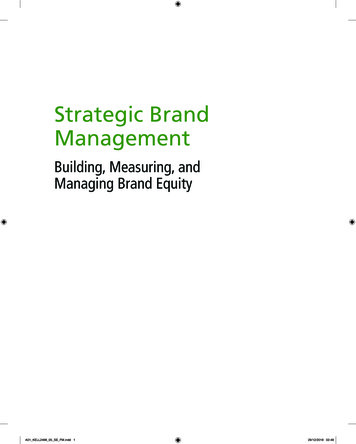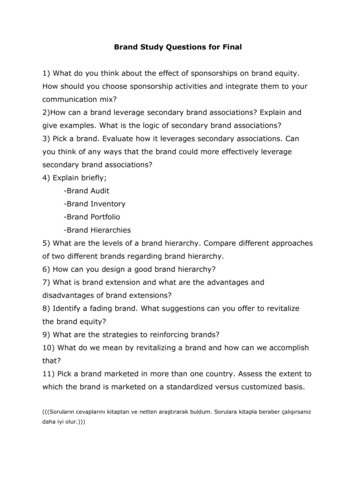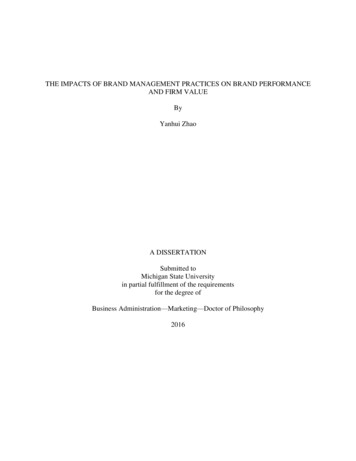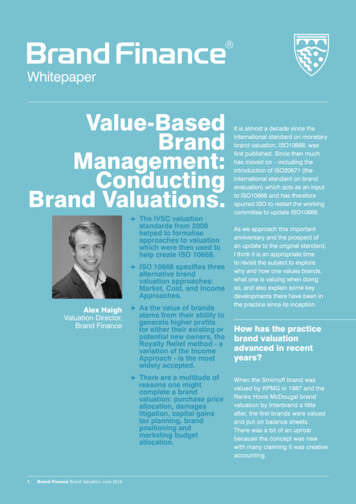
Transcription
BRAND MANAGEMENTwww.eiilmuniversity.ac.in
Subject: BRAND MANAGEMENTCredits: 4SYLLABUSBranding ConceptsIntroduction to Brand; Brand and Branding Basics; Relationship of Brands with Customers; BuildingSuccessful Brands.Terms associated with BrandsUnderstanding Various Terms; Brand Names and Brand Extensions; Co-Banding and Corporate Branding;Brand Associations and Brand Image.Management of BrandBrand Loyalty; Brand Relationship; Brand Equity; Brand ManagementBrand ProcessingBrand Evolution; Value of Brand; Brand Planning and Brand Potential.Brand SelectionBrand and Consumer Buying Process; Consumer Search for Brand Information; Issues associated withEffective Brand Name; Added Values Beyond Functionalism; Brand Personality; Branding to make Tangiblethe Intangible.Suggested Reading:1. Branding Concepts and Process by Pati D, Publisher: Macmillan2. Creating Powerful Brands by McDonald Malcolm and De Chernatony L,Publisher: Amazon.Co.UK3. Brand Positioning by Subroto Sen Gupta, Publisher: Tata McGraw-Hill4. Product Management in India by R. C. Majumdar, Publisher: Prentice-hall ofIndia Pvt Ltd.5. Managing Indian Brands by S R Kumar, Publisher: Wharton School Publishing
BRAND MANAGMENTCOURSE OVERVIEWA good brand is priceless to any business, and with this course identify the responsibilities of a brand manager.in Brand Management you will learn exactly how to market, evaluate brands to identify the components of brand equity. use Porter’s Method of Competitive Strategy to implement amarketing strategy for a brand in a given scenario. identify appropriate steps for evaluating brands in a givenscenario.success: a brand manager, a brand, and the consumer. But how recognize the benefits of having an effective brand.do these ingredients relate and what are they comprised of that identify examples of business properties that can bebranded. determine the appropriate strategy for a product within thebrand hierarchy in a given scenario.long-lasting brand. First, you will learn about the responsibili- evaluate the effectiveness of the creative elements in brands.ties of a brand manager, from conception of a brand to identify a strategy to negotiate trends in the marketplace.building, evaluating, and maintaining brand equity. Then, you recognize the benefits of knowing your consumers.will be introduced to a brief history of branding and its analyze a question used in consumer research to determinewhich method was used. identify examples of sales promotional tools. analyze a brand to determine where the consumer adoptionprocess failed.manage, develop and integrate a brand in both the marketplaceand over the Internet.There are three ingredients every company needs for brandingmakes them so important? This course will demonstrate howeach ingredient reacts to the other in order to create a valuable,intended purpose. This also includes the elements of a greatbrand, and current trends in branding. Finally, you will recognizethe components and intricacies that make up your consumer,how to appeal to the consumer, and one of the most important facts of all: how the consumer dictates your brand equity.By the end of this course, you will apply all of these ingredientsand assemble a recipe of your own as a foundation for effectivemanagement of your brand.This course is an overview for future managers, brand managersand marketing personnel who wish to conceive, build, improveand maintain a successful brand identity for their products andcompany. This will help them to interpret the potential affectsof various brand strategies and tactics and assess the value ofany type of brand. recognize the benefits of utilizing a brand manager.i
BRAND MANAGMENTBRAND MANAGMENTCONTENTS.viLesson No.TopicPage No.Lesson 1Introduction to Brand1Lesson 2Brands and Branding Basics6Lesson 3The nature of relationship of brand with customers13Lesson 4Building Successful Brands21Lesson 5Understanding various Terms29Lesson 6Brand Names and Brand Extensions35Lesson 7Co-Branding and Corporate Branding43Lesson 8Brand Associations and Brand Image48Lesson 9Brand Loyalty55Lesson 10Brand Relationship63Lesson 11Brand Equity68Lesson 12Brand Management Process75Lesson 13Brand Evolution83Lesson 14Value of brands90Lesson 15Brand Planning and Brand Potential94Lesson 16Brands and consumer buying process101Lesson 17Consumer search for Brand Information108Lesson 18Issues associated with effective brand names and114Lesson 19Added values beyond functionalism122Lesson 20Brand Personality131Lesson 21Branding to make tangible the intangible137
BRAND MANAGMENTBRAND MANAGMENTCONTENTS.Chapter No.TopicPage No.Lesson 22Response of Weak and strong manufacturers144Lesson 23Brand Positioning Strategies152Lesson 24Consumer Segmentation157Lesson 25Brand Architecture and Brand Portfolio162Lesson 26Perceptual Mapping168Lesson 27Brand Benefits and Attributes175Lesson 28Advertising and Branding181Lesson 29Successful Repositioning187Lesson 30Differential Advantage and Positioning194Lesson 31Brand as strategic devices202Lesson 32Brand Evaluation and Planning210Lesson 33Protecting Brands through Trademarks221Lesson 34Legal Perspectives in Branding232Lesson 35Online Branding236Lesson 36Business to Business Branding247Lesson 37Live Industry Projects251vii
UNIT IFOUNDATION OF BRAND MANAGEMENTLESSON 1:UNIT 1CHAPTER 1INTRODUCTION TO BRANDBRANDING CONCEPTSThe learning objective: after this lecture you should be able tounderstand:a. Why studying Brand management is important formarketing managers.b. Various terms related to Brand in terms of Glossary aregiven in this lesson, which will help you in understandingthe course better.It has never been clearer that in this shrinking world, countriesand regions and cities have to compete with each other – fortourism, for inward investment, for aid, for membership of thesupranational groups, for buyers of their products and services,for talent. So there’s hardly a place left that isn’t thinking hardabout its brand image, and most are in need of clear, realisticstrategies for communicating and promoting themselves, theirculture, their exports, their acts of policy and their contributionto the global community.Which consultants or agencies will ultimately lead the field inmanaging and promoting these hugely complex and oftencontradictory megabrands? Is promoting a country more aboutpolicy, management consultancy, public relations, marketing,CRM, advertising or brand strategy? Or is it a combination ofeverything that working with companies has taught us in thelast fifty years?Guest-Editor Simon Anholt - one of the leading internationalmarketing thinkers, and according to The Economist “one ofthe world’s leading consultants to corporations and governments who wish to build global brands” - has united theleading academics and practitioners in this critical but still largelyunexplored field to bring together the best and latest thinkingon place marketing.A strong brand is the most valuable asset of many successfulcompanies. Brands are assets because, when properly managed,they provide a secure stream of income for the business. Butwhat about your own brand, is it delivering its full value?This course provides resources to help you successfullymanage your brandAs you work to unlock the potential of your own brand you arefacing a wide range of brand management issues. You areprobably asking questions such as:What are We Trying to Achieve? Who should be involved? How do we manage this? What are the tools and techniques to use? How do we know we’re making progress?There are three steps to the answersStep OneRead about successful brand management. This courseprovides you with illustrations and anecdotes from the worldof brand management. You’ll see what worked for othercompanies and find ideas that you can apply to your ownbrand.BRAND MANAGMENTObjectivesStep TwoLearn the principles and practices. Subscribe to our ‘SharedLearning’ newsletter and learn the principles and practices ofsuccessful brand management - you’ll be another step closer tounlocking the potential of your brand.Step ThreeApply proven tools and techniques. This brand Manualprovides proven tools and techniques - and a complete brandmanagement process - to help you unlock the value of yourmost important asset, your brand.Glossary of TermsA. Awareness The percentage of population or target marketwho are aware of the existence of a given brand orcompany. There are two types of awareness: spontaneous,which measures the percentage of people whospontaneously mention a particular brand when asked toname brands in a certain category; and prompted, whichmeasures the percentage of people who recognise a brandfrom a particular category when shown a list.B. Brand A brand is a mixture of attributes, tangible andintangible, symbolised in a trademark, which, if managedproperly, creates value and influence.“Value” has different interpretations: from a marketing orconsumer perspective it is “the promise and delivery of anexperience”; from a business perspective it is “the securityof future earnings”; from a legal perspective it is “aseparable piece of intellectual property.” Brands offercustomers a means to choose and enable recognition withincluttered markets.Brand Architecture How an organization structures andnames the brands within its portfolio. There are three maintypes of brand architecture system: monolithic, where thecorporate name is used on all products and services offeredby the company; endorsed, where all sub-brands are linkedto the corporate brand by means of either a verbal or visualendorsement; and freestanding, where the corporate brandoperates merely as a holding company, and each product orservice is individually branded for its target market.Brand Associations The feelings, beliefs and knowledgethat consumers (customers) have about brands. Theseassociations are derived as a result of experiences and mustbe consistent with the brand positioning and the basis ofdifferentiation.1
BRAND MANAGMENTBrand Commitment The degree to which a customer iscommitted to a given brand in that they are likely to repurchase/re-use in the future. The level of commitmentindicates the degree to which a brand’s customer franchise isprotected form competitors.Brand Earnings The share of a brand-owning business’scashflow that can be attributed to the brand alone.Brand Equity The sum of all distinguishing qualities of abrand, drawn from all relevant stakeholders, that results inpersonal commitment to and demand for the brand; thesedifferentiating thoughts and feelings make the brand valuedand valuable.Brand Essence The brand’s promise expressed in thesimplest, most single-minded terms. For example, Volvo safety; AA Fourth Emergency Service. The most powerfulbrand essences are rooted in a fundamental customer need.Also, in Interbrand’s model, a vivid distillation of theBrand Platform.Brand Experience The means by which a brand is createdin the mind of a stakeholder. Some experiences arecontrolled such as retail environments, advertising,products/services, websites, etc. Some are uncontrolled likejournalistic comment and word of mouth. Strong brandsarise from consistent experiences which combine to form aclear, differentiated overall brand experience.Brand Extension Leveraging the values of the brand totake the brand into new markets/sectors.Brand Harmonisation Ensuring that all products in aparticular brand range have a consistent name, visualidentity and, ideally, positioning across a number ofgeographic or product/service markets.Brand Identity The outward expression of the brand,including its name and visual appearance. The brand’sidentity is its fundamental means of consumer recognitionand symbolizes the brand’s differentiation fromcompetitors.Brand Image The customer’s net “out-take” from thebrand. For users this is based on practical experience of theproduct or service concerned (informed impressions) andhow well this meets expectations; for non-users it is basedalmost entirely upon uninformed impressions, attitudesand beliefs.Brand Licensing The leasing by a brand owner of the useof a brand to another company. Usually a licensing fee orroyalty rate will be agreed for the use of the brand.Brand Management Practically this involves managing thetangible and intangible aspects of the brand. For productbrands the tangibles are the product itself, the packaging,the price, etc. For service brands (see Service Brands), thetangibles are to do with the customer experience - the retailenvironment, interface with salespeople, overall satisfaction,etc. For product, service and corporate brands, theintangibles are the same and refer to the emotionalconnections derived as a result of experience, identity,communication and people. Intangibles are therefore2managed via the manipulation of identity, communicationand people skills.Brand Mission See Brand Platform.Brand Parity A measure of how similar, or different, differentbrands in the same category are perceived to be. Brand parityvaries widely from one category to another. It is high for petrol,for example: about 80% of respondents (BBDO survey) see noreal difference between brands. By contrast, brand parity for carsis low: only about 25% of respondents say that one make ismuch the same as another.Personality The attribution of human personality traits(seriousness, warmth, imagination, etc.) to a brand as a wayto achieve differentiation. Usually done through long-termabove-the-line advertising and appropriate packaging andgraphics. These traits inform brand behavior through bothprepared communication/packaging, etc., and through thepeople who represent the brand - its employees.Brand Platform Interbrand’s proprietary model fordefining brands. The Brand Platform consists of thefollowing elements: Brand Vision The brand’s guiding insight into its world. Brand Mission How the brand will act on its insight. Brand Values The code by which the brand lives. The brandvalues act as a benchmark to measure behaviors andperformance. Brand Personality The brand’s personality traits (See alsodefinition for Brand Personality). Brand Tone of Voice How the brand speaks to itsaudiences.Brand Positioning The distinctive position that a brandadopts in its competitive environment to ensure thatindividuals in its target market can tell the brand apart fromothers. Positioning involves the careful manipulation ofevery element of the marketing mix.Brand Strategy A plan for the systematic development of abrand to enable it to meet its agreed objectives. The strategyshould be rooted in the brand’s vision and driven by theprinciples of differentiation and sustained consumer appeal.The brand strategy should influence the total operation of abusiness to ensure consistent brand behaviors and brandexperiences.Brand Tone of Voice See Brand Platform.Brand Valuation The process of identifying and measuring theeconomic benefit - brand value - that derives from brandownership.Brand Values The code by which the brand lives. The brandvalues act as a benchmark to measure behaviors and performance. (See also Brand Platform.)Brand Vision See Brand Platform.Branding Selecting and blending tangible and intangibleattributes to differentiate the product, service or corporation inan attractive, meaningful and compelling way.C. Co-branding The use of two or more brand names insupport of a new product, service or venture.
Core Competencies Relates to a company’s particular areasof skill and competence that best contribute to its ability tocompete.Corporate Identity At a minimum, is used to refer to thevisual identity of a corporation (its logo, signage, etc.), butusually taken to mean an organization’s presentation to itsstakeholders and the means by which it differentiates itselffrom other organizations.Country of Origin The country from which a givenproduct comes. Customers’ attitudes to a product and theirwillingness to buy it tend to be heavily influenced by whatthey associate with the place where it was designed andmanufactured.Customer Characteristics All distinguishing, distinctive,typical or peculiar characteristics and circumstances orcustomers that can be used in market segmentation to tellone group of customers from another.Customer Relationship Management (CRM) Trackingcustomer behavior for the purpose of developingmarketing and relationship-building processes that bondthe consumer to the brand. Developing software or systemsto provide one-to-one customer service and personalcontact between the company and the customer.Customer Service The way in which the brand meets itscustomers’ needs via its various different channels (forexample, over the telephone or Internet in the case ofremote banking, or in person in the case of retail orentertainment).D Demographics The description of outward traits thatcharacterize a group of people, such as age, sex, nationality,marital status, education, occupation or income. Decisionson market segmentation are often based on demographicdata.Differential Product Advantage A feature of a productthat is valuable to customers and is not found in otherproducts of the same category.Differentiation Creation or demonstration of uniquecharacteristics in a company’s products or brands comparedto those of its competitors.Differentiator Any tangible or intangible characteristic thatcan be used to distinguish a product or a company fromother products and companies.E Endorsed brand (See Brand Architecture.) Generally aproduct or service brand name that is supported by amasterbrand - either dominantly e.g. Tesco Metro or lightlye.g. Nestle Kit-Kat.FFMCG Fast moving consumer goods. An expression usedto describe frequently purchased consumer items, such asfoods, cleaning products and toiletries.Focus Group A qualitative research technique in which agroup of about eight people is invited to a neutral venue todiscuss a given subject, for example hand-held power tools.The principle is the same as an in-depth interview, exceptthat group dynamics help to make the discussion livelierand more wide-ranging. Qualitative groups enable theresearcher to probe deeper into specific areas of interest (forexample, the nature of commitment to a brand). The resultadds richer texture to the understanding of broader data(for example, quantitative), which may paint general trendsor observations. Also known as a group discussion.Freestanding Brand (See Brand Architecture.) A brandname and identity used for a single product or service in aportfolio, which is unrelated to the names and identities ofother products in the company’s portfolio.Functionality What a product does for the buyer and user;the utility it offers the user; what he or she can do with it.G Goods A product consisting predominantly of tangiblevalues. Almost all goods, however, have intangible valuesto a greater or lesser extent.Group Discussion See Focus GroupH High Technology (high tech) A term with vague and farreaching meaning. This covers electronics, data technology,telecommunications, medical technology and bio-chemistry.In order to be classed as a high tech company, onedefinition is that at least 35 percent of staff should have atechnical qualification, and at least 15 percent of sales shouldbe used for R&D. Another definition states that thecompany must employ twice as many scientists andengineers and invest twice as much in R&D as the averageof all manufacturing companies in the country.I Intangibles “Intangible” - incapable of being touched. (1)Intangible assets - trademarks, copyrights, patents, designrights, proprietary expertise, databases, etc. (2) Intangiblebrand attributes - brand names, logos, graphics, colors,shapes and smells. (See Service Brand.)L Launch The initial marketing of a new product in aparticular market. The way in which the launch is carried outgreatly affects the product’s profitability throughout itslifecycle.M Market Leader A company that has achieved a dominantposition - either in scale (e.g., British Airways) or influence(e.g., Virgin) - within its field. This leading position oftencomes about because the company was the first to market acertain type of product and, with the protection of a patent,has managed to consolidate its position before directcompetition was possible. Alternatively, a company mayovertake a previous market leader through greater efficiencyand skilful positioning.Market Position A measure of the position of a companyor product on a market. Defined as market share multipliedby share of mind.Market Segment A group of customers who (a) share thesame needs and values, (b) can be expected to respond inmuch the same way to a company’s offering, and (c)command enough purchasing power to be of strategicimportance to the company.3BRAND MANAGMENTConsumer Product Goods (consumer goods) or services(consumer services) purchased for private use or for othermembers of the household.
BRAND MANAGMENTMarket Share A company’s share of total sales of a givencategory of product on a given market. Can be expressedeither in terms of volume (how many units sold) or value(the worth of units sold).Mass Marketing Simultaneous standardized marketing toa very large target market through mass media. Other namesfor this are market aggregation and undifferentiatedmarketing.Masterbrand A brand name that dominates all products orservices in a range or across a business. Sometimes usedwith sub-brands, sometimes used with alpha or numericsignifiers. (See also Monolithic Brand.) Audi, Durex,Nescafe and Lego, for example, are all used as masterbrands.Monolithic Brand A single brand name that is used to“masterbrand” all products or services in a range. Individualproducts are nearly always identified by alpha or numericsignifiers. Companies like Mercedes and BMW favor suchsystems.Multibrand Strategy /Multiple Branding Marketing oftwo or more mutually competing products under differentbrand names by the same company. The motive may be thatthe company wishes to create internal competition topromote efficiency, or to differentiate its offering to differentmarket segments, or to get maximum mileage out ofestablished brands that it has acquired. When a companyhas achieved a dominant market share, multibrand strategymay be its only option for increasing sales still furtherwithout sacrificing profitability. For example, Lever Brotherssells washing powders under the Persil, Omo and Surfnames; Cadbury sells chocolates under the Dairy Milk,Bournville and Fruit & Nut names; Heinz sells cannedconvenience foods under the Baked Beans, Spaghetti Hoopsand Alphabetti Spaghetti names.very small segments. Niche marketing characteristically usesselective media.O OEM market OEM stands for Original EquipmentManufacturers. The OEM market consists of companiesthat use another company’s product as a component in theirown production. A manufacturer of ball bearings, forexample, sells both to OEM customers who build thebearings into machines, and to end users who need thebearings as spare parts for machines that they have boughtfrom the OEMs. Most manufacturing companies thus havean OEM market and a replacement market. The latter isusually called the MRO market or aftermarket.Offering What a company offers for sale to customers. Anoffering includes the product and its design, features,quality, packaging, distribution, etc., together with associatedservices such as financing, warranties and installation. Thename and brand of the product are also part of theoffering.P Packaging Design The design of the pack format andgraphics for a product brand.Parent Brand A brand that acts as an endorsement to oneor more sub-brands within a range.Passing Off The name given to a legal action brought toprotect the “reputation” of a particular trademark/brand/get up. In essence, the action is designed to prevent othersfrom trading on the reputation/goodwill of an existingtrademark/brand/get up. The action is only available inthose countries that recognize unregistered trademark rights(for example the UK and US). In some countries, it is called“unfair competition action.” Descriptive name A name which describes the product orservice for which it is intended, e.g., TALKING PAGES.Perceptual Mapping Graphic Analysis and presentationof where actual and potential customers place a product orsupplier in relation to other products and suppliers. Mostperceptual maps show only two dimensions at a time, forexample price on one axis and quality on the other. Therealso are methods of graphically analyzing and presentingmeasurement data in three or more dimensions. Associative name A name which alludes to an aspect orbenefit of the product or service, often by means of anoriginal or striking image or idea, e.g., VISA.Positioning Statement A written description of theposition that a company wishes itself, its product or itsbrand to occupy in the minds of a defined target audience. Freestanding name A name which has no link to theproduct or service but which might have meaning of itsown, e.g., PENGUIN.Power Branding A strategy in which every product in acompany’s range has its own brand name which functionsindependently, unsupported by either the company’scorporate brand or its other product brands. Powerbranding is a resource-intensive strategy, since each brandmust be commercially promoted and legally protected. Thisstrategy is used mainly by manufacturers of consumergoods. Lever’s and Procter & Gamble’s detergents are goodexamples of power brands.N Names There are three basic categories of brand (orcorporate) name:The following are also helpful: Abstract name A name which is entirely invented and hasno meaning of its own, e.g., ZENECA. Abstract names area sub-set of freestanding names because they also have nolink to the product of service. Coined name Any name which is in some way invented.Coined names can be descriptive (CO-CREATE),associative (IMATION) and freestanding/abstract(ZENECA). 4Niche Marketing Marketing adapted to the needs, wishesand expectations of small, precisely defined groups ofindividuals. A form of market segmentation, but aimed atProduct Brand A brand which is synonymous with aparticular product offering, for example, Cheerios.R Rebrand When a brand owner revisits the brand with thepurpose of updating or revising based on internal orexternal circumstances. Rebranding is often necessary afteran M&A or if the brand has outgrown its identity/marketplace.
Relaunch Reintroducing a product into a specific market.The term implies that the company has previously marketedthe product but stopped marketing it. A relaunched producthas usually undergone one or more changes. It may, forexample, be technically modified, rebranded, distributedthrough different channels or repositioned.Repositioning Communications activities to give anexisting product a new position in customers’ minds and soexpanding or otherwise altering its potential market. Manypotentially valuable products lead an obscure existencebecause they were launched or positioned in an inadequatemanner. It is almost always possible to enhance the valueof such products by repositioning them.Rollout The process by which a company introduces a newproduct or service to different geographical markets orconsumer segments.SSelective Media Media that, unlike mass media, reach onlysmall and identifiable groups of people, for example,members of a particular profession or industry or othergroups defined by geographic, demographic orpsychographic data (otherwise known as targeted media).Service Brand A product consisting predominantly ofintangible values. “A service is something that you can buyand sell, but not drop on your foot” (The Economist). Inthis sense, a service is something that you do forsomebody, or a promise that you make to them.Share of Mind There are many definitions of share ofmind. At its most precise, share of mind measures howoften consumers think about a particular brand as apercentage of all the times they think about all the brands inits category. More loosely, share of mind can be definedsimply as positive perceptions of the brand obtained bymarket research. Whereas market share measures the widthof a company’s market position, share of mind can be saidto measure its depth.Target Market The market segment or group ofcustomers that a company has decided to serve, and atwhich it consequently aims its marketing activities.Top-of-Mind What is present in the uppermost level ofconsciousness; the manufacturer or brand that people inmarket surveys name first when asked to list products in aspecific category. Top-of-mind is the highest degree of shareof mind. To attain that position, a company normally needsto have a large share of voice in its category.Trademark “Any sign capable of being representedgraphically which is capable of distinguishing goods orservices of one undertaking from those of anotherundertaking” (UK Trade Marks Act 1994).Trademark Infringement A trademark registration isinfringed by the unauthorized use of the registeredtrademark, or of one that is confusingly similar to it, on theregistered goods or services, or in certain circumstances onsimilar or dissimilar goods and services.Trendsetter Someone or thing that breaks a traditionalmold or routine and gains a following because of it. iMac isan example of trendsetting in design as now office suppliescome in the familiar colors and translucent packaging of aniMac.U User Segmentation Division of potential customers intomarket segments according to how and for what purposethey use a product. Do they use it for cleaning their teeth orfor making cakes (baking powder)? For oiling their hair orfor frying food? (True story concerning use of Brylcreem inNigeria). As a decongestant chest rub or as an aphrodisiac?(True story concerning Ribby Rub in Caribbean).V Visual Identity What a brand looks like - including, amongother things, its logo, typography, packaging and literaturesystems.NotesShare of Voice The media spending of a particular
successful brand management - you’ll be another step closer to unlocking the potential of your brand. Step Three Apply proven tools and techniques. This brand Manual provides proven tools and techniques - and a complete brand management process - to help you unlock the value of
